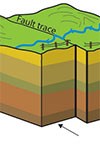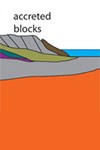[Site Under Development]
Follow this link to the active Tectonic Landforms website

Introduction
Tectonic processes shape the landscape and form some of the most spectacular structures found in national parks, from the highest peaks in the Rocky Mountains to the faulted mountains and valleys in the Basin and Range Province. Understanding a park's plate tectonic history and setting can help you make sense of the landforms and scenery you see.
For more information on Plate Tectonics, visit:
Tectonic Landforms—Mountain Building
The motions of the plates have a tremendous ability to shape and deform rocks through a variety of processes that include folding, faulting, extension, and on a massive scale, mountain building.
Fault-block Mountains

When divergent plate motion occurs beneath a continental crust, rift structures and normal faults form. This continental rifting causes valleys floors to drop down along fault lines. The combination of down dropped basins and adjacent fault-block mountains can produce dramaic range fronts.
Saguaro National Park, Arizona


Left image
Tuscon Basin.
Credit: NPS photo.
Right image
Feature labels.
Example above modified from “Parks and Plates: The Geology of our National Parks, Monuments and Seashores,” by Robert J. Lillie, New York, W. W. Norton and Company, 298 pp., 2005, www.amazon.com/dp/0134905172.
Featured Video—Grand Teton National Park, Wyoming
Examples from the Basin and Range Province
- The Snake Valley (basin) and the adjacent Snake Range mountains [Great Basin]
- The Tucson Basin and the adjacent Rincon Mountains [Saguaro]
- Death Valley (basin) and the adjacent Panamint Mountains [Death Valley]
Learn More
- Death Valley National Park, California & Nevada—[Geodiversity Atlas] [Park Home]
- Grand Teton National Park, Wyoming—[Geodiversity Atlas] [Park Home]
- Great Basin National Park, Nevada—[Geodiversity Atlas] [Park Home]
- Saguaro National Park, Arizona—[Geodiversity Atlas] [Park Home]
Fold Mountains and Foreland Basins [Site Under Development]

[Site Under Development]
Learn More
- Tectonic Settings of NPS Sites—-Convergent Plate Boundary—Collisional Mountain Range
Volcanic Mountains [Site Under Development]

[Site Under Development]
Volcanic Arc...
A hot spot is area of concentrated heat in the mantle that produces magma that rises to the Earth’s surface to form volcanic features. The volcanic activity of the Hawaiian Islands is one example. Hot spots may persist for millions of years.
Examples of Hotspots and Volcanic Arcs
- Yellowstone National Park, Wyoming, Idaho & Montana—[Geodiversity Atlas] [Park Home]
- Hawaii Volcanoes National Park, Hawaii—[Geodiversity Atlas] [Park Home]
-
Katmai National Park and Preserve, Alaska—[Geodiversity Atlas] [Park Home]
-
Kenai Fjords National Park, Alaska—[Geodiversity Atlas] [Park Home]
-
Lake Clark National Park and Preserve, Alaska—[Geodiversity Atlas] [Park Home]
Learn More
- Tectonic Settings of NPS Sites—Divergent Plate boundary—Continental Rift
- Tectonic Settings of NPS Sites—-Convergent Plate Boundary—Subduction Zone
- Tectonic Settings of NPS Sites—-Hotspot—Oceanic
- Tectonic Settings of NPS Sites—-Hotspot—Continental
- Volcanoes, Craters & Lava Flows
Geoscience Concepts—Plate Tectonics
- Types of Plate Boundaries
- Inner Earth Model
- The Action is at The Edges
- Evidence of Plate Motions
- Tectonic Landforms & Features
--------------------------------------------------------
Older Content to be Removed or Relocated
--------------------------------------------------------------------
Transform Plate Boundaries in Parks
At transform plate boundaries plates grind past each other side by side. This type of boundary separates the North American plate from the Pacific plate along the San Andreas fault, a famous transform plate boundary that’s responsible for many of California’s earthquakes.

Hot Spots in Parks
A hot spot is area of concentrated heat in the mantle that produces magma that rises to the Earth’s surface to form volcanic features. The volcanic activity of the Hawaiian Islands is one example. Hot spots may persist for millions of years.

Accreted Terrains in Parks
Accreted terrains are portions of crust that are too thick and buoyant to be subducted which are "scraped off" and become added to the over-riding tectonic plate along a convergent (collisional) plate boundary.
Parks and Plates Textbook

Parks and Plates: The Geology of Our National Parks, Monuments & Seashores. Lillie, Robert J., 2005.
W.W. Norton and Company.
ISBN 0-393-92407-6
9" x 10.75", paperback, 550 pages, full color throughout
Ever have questions about the fascinating natural dynamics working in our national parks? This book aims to provide answers to some of them. The spectacular geology in our national parks provides the answers to many questions about the Earth. The answers can be appreciated through plate tectonics, an exciting way to understand the ongoing natural processes that sculpt our landscape. Parks and Plates is a visual and scientific voyage of discovery!
Last updated: August 8, 2023
